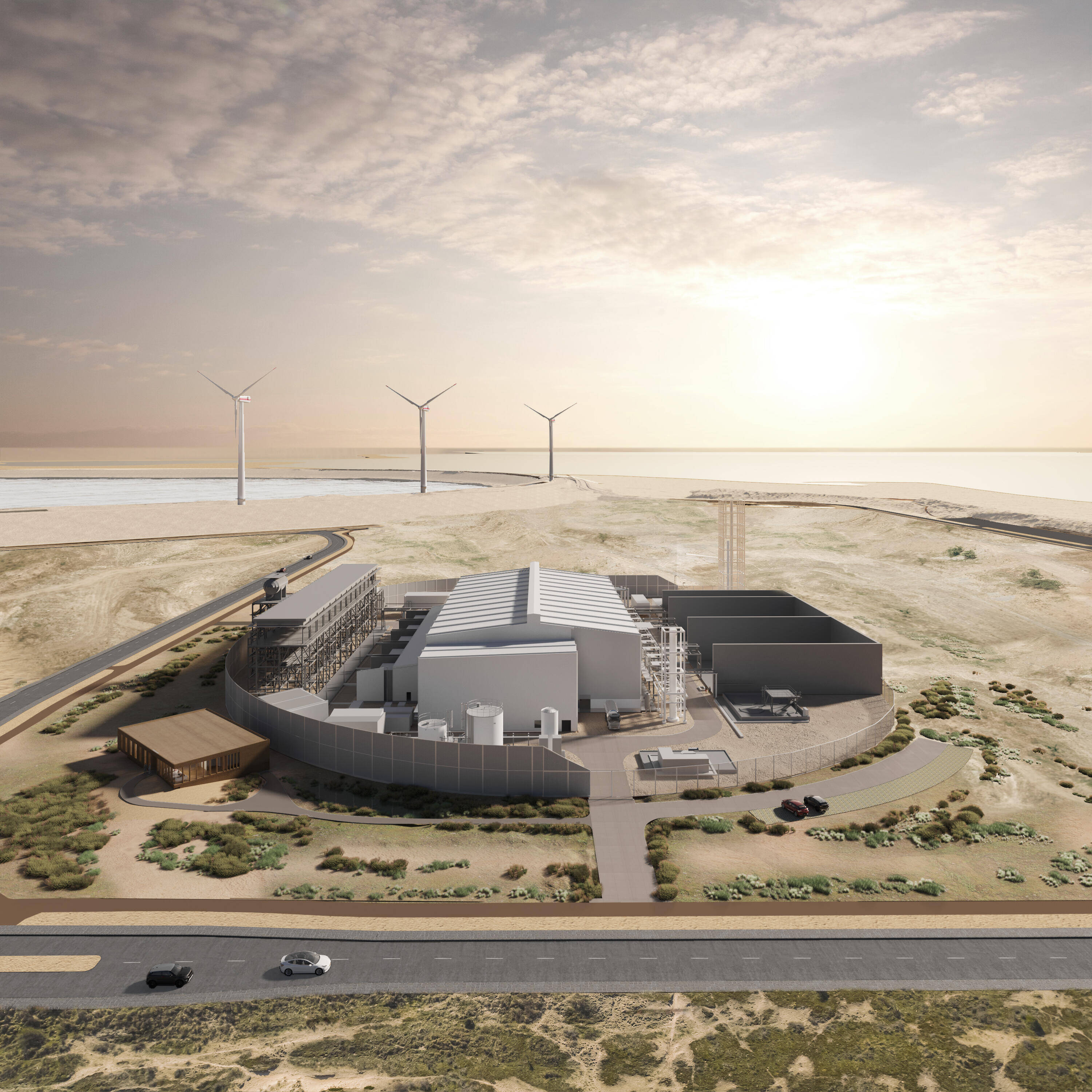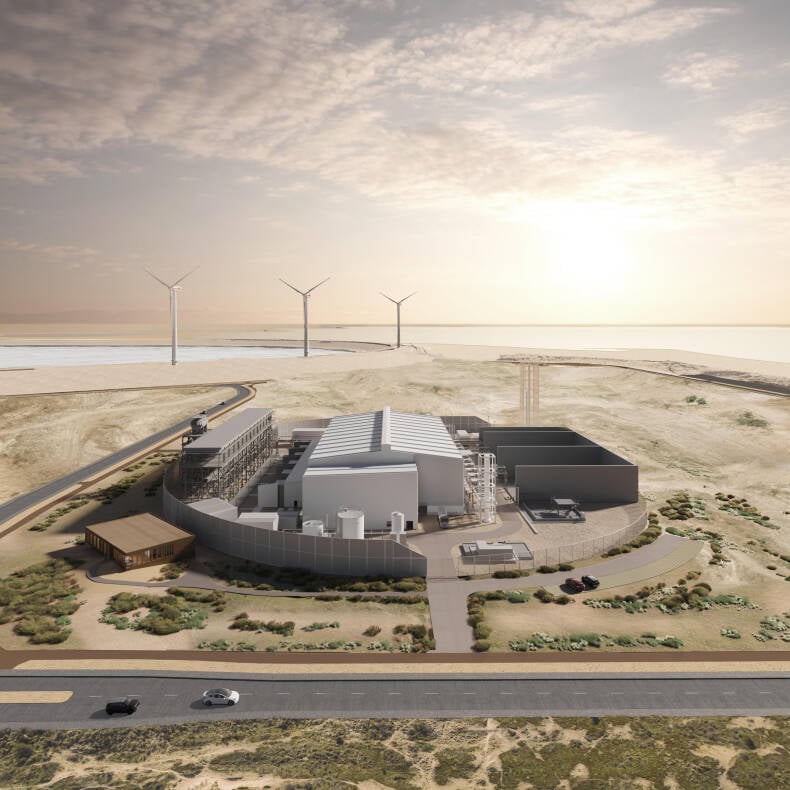Artist impression of Holland Hydrogen 1 when finished. Image: Plotvis
Scroll down
With this development, along with the announced electrolysers on Uniper and Eneco's own site, the port of Rotterdam is positioning itself as the hub for green hydrogen production in the Netherlands. However, all these green hydrogen plants fall far short of meeting the industry’s needs to transition to green energy. The substantial volumes of green hydrogen will soon arrive at the port from sunny and windy regions abroad. It will come from countries with far greater potential to generate solar and wind energy, where surplus energy can be exported as hydrogen. Once that development scales up, the price of green hydrogen will also be able to fall. Thus, the contours of a future-proof hydrogen ecosystem are becoming ever more defined.
Construction overview
Windy
While TenneT is currently developing a large-scale landing point for offshore wind power, preparations are underway at this second site for up to 1 GW electrolysis capacity on the Maasvlakte. The Port of Rotterdam Authority reserved this plot for the winner of the tender for wind farm IJmuiden Ver Beta. That honour fell to Zeevonk II, a joint venture between Copenhagen Infrastructure Partners (CIP) and Vattenfall.
The wind farm will be constructed in two phases. First, 1 GW of offshore wind power will be realised in 2029. The completion of another 1 GW is scheduled for 2032, with the electrolyzer (1st phase 500 MW, 2nd phase adding up to 1GW) expected to follow in 2033. This aligns with the anticipated timing of the completion of the Delta Rhine Corridor, which will facilitate the transportation of green hydrogen to customers in the Netherlands and potentially neighbouring countries.
Winner
On the site where Shell’s Holland Hydrogen 1 currently stands alone, a cluster of hydrogen giants is gradually beginning to take shape. Meanwhile, two new, equally large electrolyser projects have been announced, further establishing the Maasvlakte as the heart of green hydrogen production. At the World Hydrogen Summit last May, HYCC announced plans to develop 'H2Next' — a facility designed to produce 25,000 tonnes of green hydrogen annually. And in the midst of summer, Air Liquide made the final investment decision (FID) for the construction of ‘ELYgator’, a 200 MW electrolyser that will supply 23,000 tonnes of hydrogen per year, generated from wind power. A significant portion of this hydrogen is destined for TotalEnergies’ industrial platform under a long-term contract. Construction has already started.
Air Liquide operates its own hydrogen network. To supply power, Air Liquide utilises renewable energy from the OranjeWind wind farm, co-owned by TotalEnergies. This is supplemented by power sourced through Power Purchase Agreements with Vattenfall, originating from the Hollandse Kust Zuid offshore wind farm. ELYgator is scheduled for completion by the end of 2027. HYCC is targeting an investment decision in 2028, aiming to be operational by 2030 – and this need not end here. The Port of Rotterdam Authority has the ambition to fill a fourth plot with another project on the site. This could create a cloverleaf of electrolysers on the Maasvlakte. And a bit further on, a significant number of hectares have also been set aside for hydrogen production.
On a rainy autumn day in 2023, King Willem-Alexander officially launched the construction of this vital infrastructure, also marking the beginning of the national hydrogen network’s development. The investment decision in 2022 to proceed with the construction of Holland Hydrogen 1 provided momentum for building the 32-kilometre hydrogen pipeline through the port area. Through this pipeline, green hydrogen will soon be transported eastwards from the conversion park towards industry. Upstream, the chain begins several kilometres further out to sea, at the Hollandse Kust Noord offshore wind farm. Located 18 kilometres off the coast near Egmond aan Zee, this wind farm is operated by CrossWind, a joint venture between Shell and Eneco. This park supplies the plant with green electricity, which it uses to split water into oxygen and hydrogen.
While kitesurfers to the west of the site harness the wind in their sails, that same wind will be converted into green hydrogen from 2026. This will take place in Shell's Holland Hydrogen 1 (HH1), a substantial building that rose on the conversion park this year. It is the first plant to supply green hydrogen to the hydrogen network, which is currently under construction between the Maasvlakte and the Rotterdam Chemicals Park in Pernis. This is no coincidence as the Pernis refinery is set to become its first customer. Around 60 tonnes of green hydrogen will be able to flow through the network each day between the Maasvlakte and Pernis.

Cloverleaf
Seaward
At the southernmost tip of the Maasvlakte, where the wind roams freely, an impressive new chapter in the energy transition is unfolding. Between the Slufter and the striking Portlantis building, known for its rotated floors and red staircases, stretches a vast area of land where, since last year, a tall off-white building has been taking shape. This is the first electrolyser at the so-called 'Conversion Park 1' – an area for four electrolysers, each with a capacity of 200 to 250 megawatts.
From wind to hydrogen on the Maasvlakte
BUILDING THE FUTURE
Construction overview
With this development, along with the announced electrolysers on Uniper and Eneco's own site, the port of Rotterdam is positioning itself as the hub for green hydrogen production in the Netherlands. However, all these green hydrogen plants fall far short of meeting the industry’s needs to transition to green energy. The substantial volumes of green hydrogen will soon arrive at the port from sunny and windy regions abroad. It will come from countries with far greater potential to generate solar and wind energy, where surplus energy can be exported as hydrogen. Once that development scales up, the price of green hydrogen will also be able to fall. Thus, the contours of a future-proof hydrogen ecosystem are becoming ever more defined.
Windy
While TenneT is currently developing a large-scale landing point for offshore wind power, preparations are underway at this second site for up to 1 GW electrolysis capacity on the Maasvlakte. The Port of Rotterdam Authority reserved this plot for the winner of the tender for wind farm IJmuiden Ver Beta. That honour fell to Zeevonk II, a joint venture between Copenhagen Infrastructure Partners (CIP) and Vattenfall.
The wind farm will be constructed in two phases. First, 1 GW of offshore wind power will be realised in 2029. The completion of another 1 GW is scheduled for 2032, with the electrolyzer (1st phase 500 MW, 2nd phase adding up to 1GW) expected to follow in 2033. This aligns with the anticipated timing of the completion of the Delta Rhine Corridor, which will facilitate the transportation of green hydrogen to customers in the Netherlands and potentially neighbouring countries.
Winner
Artist impression of Holland Hydrogen 1 when finished. Image: Plotvis

On the site where Shell’s Holland Hydrogen 1 currently stands alone, a cluster of hydrogen giants is gradually beginning to take shape. Meanwhile, two new, equally large electrolyser projects have been announced, further establishing the Maasvlakte as the heart of green hydrogen production. At the World Hydrogen Summit last May, HYCC announced plans to develop 'H2Next' — a facility designed to produce 25,000 tonnes of green hydrogen annually. And in the midst of summer, Air Liquide made the final investment decision (FID) for the construction of ‘ELYgator’, a 200 MW electrolyser that will supply 23,000 tonnes of hydrogen per year, generated from wind power. A significant portion of this hydrogen is destined for TotalEnergies’ industrial platform under a long-term contract. Construction has already started.
Air Liquide operates its own hydrogen network. To supply power, Air Liquide utilises renewable energy from the OranjeWind wind farm, co-owned by TotalEnergies. This is supplemented by power sourced through Power Purchase Agreements with Vattenfall, originating from the Hollandse Kust Zuid offshore wind farm. ELYgator is scheduled for completion by the end of 2027. HYCC is targeting an investment decision in 2028, aiming to be operational by 2030 – and this need not end here. The Port of Rotterdam Authority has the ambition to fill a fourth plot with another project on the site. This could create a cloverleaf of electrolysers on the Maasvlakte. And a bit further on, a significant number of hectares have also been set aside for hydrogen production.
Cloverleaf
On a rainy autumn day in 2023, King Willem-Alexander officially launched the construction of this vital infrastructure, also marking the beginning of the national hydrogen network’s development. The investment decision in 2022 to proceed with the construction of Holland Hydrogen 1 provided momentum for building the 32-kilometre hydrogen pipeline through the port area. Through this pipeline, green hydrogen will soon be transported eastwards from the conversion park towards industry. Upstream, the chain begins several kilometres further out to sea, at the Hollandse Kust Noord offshore wind farm. Located 18 kilometres off the coast near Egmond aan Zee, this wind farm is operated by CrossWind, a joint venture between Shell and Eneco. This park supplies the plant with green electricity, which it uses to split water into oxygen and hydrogen.
Seaward
From wind to hydrogen on the Maasvlakte
At the southernmost tip of the Maasvlakte, where the wind roams freely, an impressive new chapter in the energy transition is unfolding. Between the Slufter and the striking Portlantis building, known for its rotated floors and red staircases, stretches a vast area of land where, since last year, a tall off-white building has been taking shape. This is the first electrolyser at the so-called 'Conversion Park 1' – an area for four electrolysers, each with a capacity of 200 to 250 megawatts.
BUILDING THE FUTURE
While kitesurfers to the west of the site harness the wind in their sails, that same wind will be converted into green hydrogen from 2026. This will take place in Shell's Holland Hydrogen 1 (HH1), a substantial building that rose on the conversion park this year. It is the first plant to supply green hydrogen to the hydrogen network, which is currently under construction between the Maasvlakte and the Rotterdam Chemicals Park in Pernis. This is no coincidence as the Pernis refinery is set to become its first customer. Around 60 tonnes of green hydrogen will be able to flow through the network each day between the Maasvlakte and Pernis.